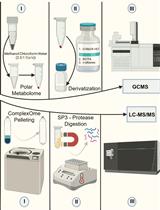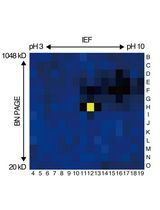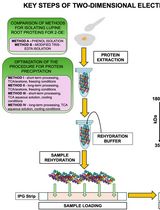- EN - English
- CN - 中文
In vitro Reconstitution Assays of Arabidopsis 20S Proteasome
拟南芥20S蛋白酶体的体外重组分析
发布: 2021年04月05日第11卷第7期 DOI: 10.21769/BioProtoc.3967 浏览次数: 5450
评审: Wenrong HeYuan WangAnonymous reviewer(s)

相关实验方案

利用SP3珠和稳定同位素质谱技术优化蛋白质合成速率:植物核糖体的案例研究
Dione Gentry-Torfer [...] Federico Martinez-Seidel
2024年05月05日 2282 阅读

基于活性蛋白质组学和二维聚丙烯酰胺凝胶电泳(2D-PAGE)鉴定拟南芥细胞间隙液中的靶蛋白酶
Sayaka Matsui and Yoshikatsu Matsubayashi
2025年03月05日 1459 阅读
Abstract
The majority of cellular proteins are degraded by the 26S proteasome in eukaryotes. However, intrinsically disordered proteins (IDPs), which contain large portions of unstructured regions and are inherently unstable, are degraded via the ubiquitin-independent 20S proteasome. Emerging evidence indicates that plant IDP homeostasis may also be controlled by the 20S proteasome. Relatively little is known about the specific functions of the 20S proteasome and the regulatory mechanisms of IDP degradation in plants compared to other species because there is a lack of systematic protocols for in vitro assembly of this complex to perform in vitro degradation assays. Here, we present a detailed protocol of in vitro reconstitution assay of the 20S proteasome in Arabidopsis by modifying previously reported methods. The main strategy to obtain the 20S core proteasome here is to strip away the 19S regulatory subunits from the 26S proteasome. The protocol has two major parts: 1) Affinity purification of 20S proteasomes from stable transgenic lines expressing epitope-tagged PAG1, an essential component of the 20S proteasome (Procedures A-D) and 2) an in vitro 20S proteasome degradation assay (Procedure E). We anticipate that these protocols will provide simple and effective approaches to study in vitro degradation by the 20S proteasome and advance the study of protein metabolism in plants.
Keywords: 26S proteasome (26S蛋白酶体)Background
In eukaryotes, protein degradation is carried out by the proteasome. The integrative 26S proteasome is comprised of two sub particles: one or two terminal 19S regulatory particle(s) (RP), which serve as a proteasome activator; and the 20S core proteasome (CP), which degrades proteins. Most eukaryotic proteins are polyubiquitinated and channeled into 26S proteasome for degradation. In contrast, proteins that contain intrinsically disordered regions have been found to be directly destroyed by the ubiquitin-independent 20S proteasome (Ben-Nissan et al., 2014). Methods to purify and assembly the 20S proteasome in vitro are well established for mammalian cells and yeast. This has led to an understanding and appreciation of the numerous ways by which IDPs interact with the 20S proteasome (Leggett et al., 2005). However, to date a detailed and efficient protocol has not been reported for the purification of the 20S proteasome from plants. Book et al. (2010) developed an affinity-based strategy to effectively isolate the 26S proteasome from Arabidopsis. In their approach, PAG1, one of the 14 core proteasome polypeptides, is epitope-tagged and immunoprecipitated with epitope-specific antibodies such that the 26S proteasome is recovered. From purification studies of the proteasome complex, there are two important components to monitor during the purification scheme: ATP amount and salt concentration (Verma et al., 2000; Leggett et al., 2002). It is known that the integrity of the RP-CP complex relies on ATP, and the abundance of RP subunits is substantially reduced if all purification steps do not include ATP. Similarly, RP subunit abundance is reduced when immunoprecipitates (IPs) are washed with a high salt buffer (800 mM NaCl) before elution (Book et al., 2010). Based on previous methods, we designed a simple approach to specifically isolate the 20S proteasome by immunoprecipitating PAG1 complexes from total protein extracts of stable transgenic lines expressing gPAG1-Flag-4Myc (gPAG1-FM) under its native promoter. In our protocol, the protein extracts are not supplied with ATP, and IPs are washed with a buffer containing 800 mM NaCl, as this stringent condition has been reported to strip the 19S regulatory subunits away from the 20S core proteasome. For in vitro protein degradation assays, we modified a protocol from yeast work with the 20S proteasome (Hsieh et al., 2015). Taken together, this protocol is easy to follow and can provide an effective strategy to study degradation of IDPs in plants. We hope that this protocol will advance research in protein metabolism and regulation in plants.
Materials and Reagents
15 ml conical tube
2 ml Eppendorf tube
1.5 ml Eppendorf tube
Pipette tips
96-well Plate (Thermo Scientific, catalog number: 249935 )
10-day-old PPAG1-gPAG1-FM transgenic seedlings
Liquid nitrogen
Tris Base (Fisher Scientific, catalog number: BP152-10 )
Sodium dodecyl sulfate (SDS) (Sigma-Aldrich, catalog number: L3771 )
NaCl (Fisher Scientific, catalog number: BP358-10 )
MgCl2 (Sigma-Aldrich, catalog number: M9272 )
EDTA (Fisher Scientific, catalog number: BP120-1 )
Dithiothreitol (DTT) (Sigma-Aldrich, catalog number: 43817 )
Glycerol (Sigma-Aldrich, catalog number: V900122 )
PMSF (Sigma-Aldrich, catalog number: 78830 )
Miracloth (Calbiochem, catalog number: 475855 )
Anti-FLAG® M2 magnetic beads (Sigma-Aldrich, catalog number: M8823 )
3× FLAG peptide (DYKDDDDK) (Sigma-Aldrich, catalog number: F4799 )
Anti-Flag (Sigma-Aldrich, catalog number: F1804 )
Anti-Myc (Sigma-Aldrich, catalog number: C3956 )
Anti-SE (Agrisera, catalog number: AS09 532A)
DMSO (Sigma-Aldrich, catalog number: D4540 )
MG132 (Calbiochem, catalog number: 474787 )
Succinyl-Leu-Leu-Val-Tyr-7-amido-4-methylcoumarin (Suc-LLVY-AMC) (Sigma-Aldrich, catalog number: S6510 )
SilverQuestTM Staining Kit (Invitrogen, catalog number: LC6070 )
Bradford Reagent (Sigma-Aldrich, catalog number: B6916 )
2× SDS-PAGE loading buffer (see Recipes)
Extraction buffer (see Recipes)
Washing buffer (see Recipes)
Reaction Buffer (see Recipes)
Equipment
-80 °C freezer
Pipettes
Centrifuge
DynaMagTM-2 (Invitrogen, model: 12321D )
PolyATtract® System 1000 Magnetic Separation Stand (Promega Corporation, model: Z5410 )
Rugged Rotator (Glas-Col, model: 099A RD4512 )
Thermomixer R (Eppendorf, model: 022679810)
Microplate spectrophotometer (PerkinElmer, model: VICTORTM X3)
Gel imaging system (Bio-Rad, model: Universal Hood II )
Vortex mixer (VWR, model: 945300 )
Procedure
文章信息
版权信息
© 2021 The Authors; exclusive licensee Bio-protocol LLC.
如何引用
Li, Y., Sun, D., Yan, X., Wang, Z. and Zhang, X. (2021). In vitro Reconstitution Assays of Arabidopsis 20S Proteasome. Bio-protocol 11(7): e3967. DOI: 10.21769/BioProtoc.3967.
分类
植物科学 > 植物生物化学 > 蛋白质 > 分离和纯化
生物化学 > 蛋白质 > 活性
分子生物学 > 蛋白质 > 靶向降解
您对这篇实验方法有问题吗?
在此处发布您的问题,我们将邀请本文作者来回答。同时,我们会将您的问题发布到Bio-protocol Exchange,以便寻求社区成员的帮助。
提问指南
+ 问题描述
写下详细的问题描述,包括所有有助于他人回答您问题的信息(例如实验过程、条件和相关图像等)。
Share
Bluesky
X
Copy link









